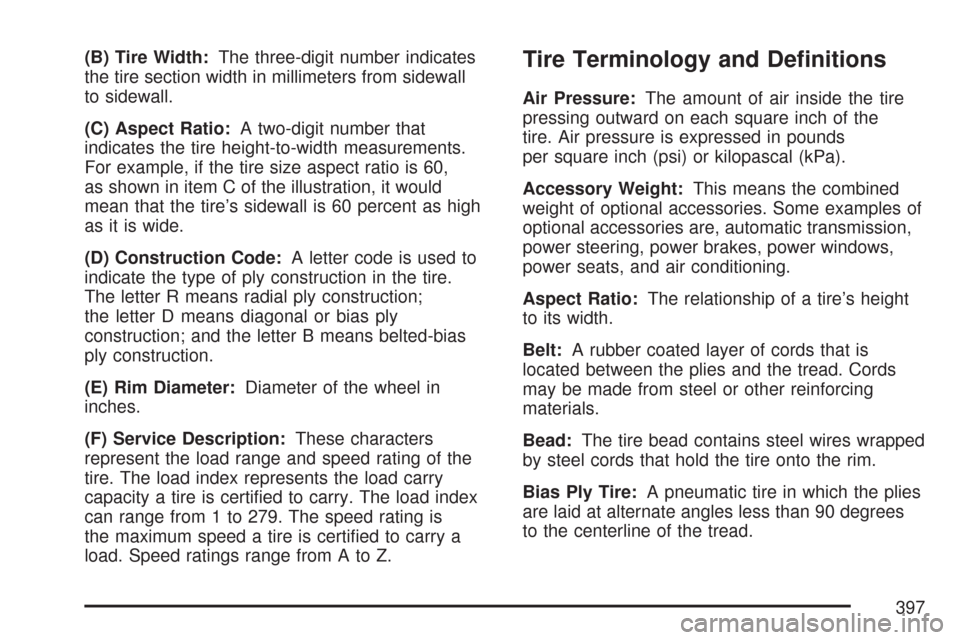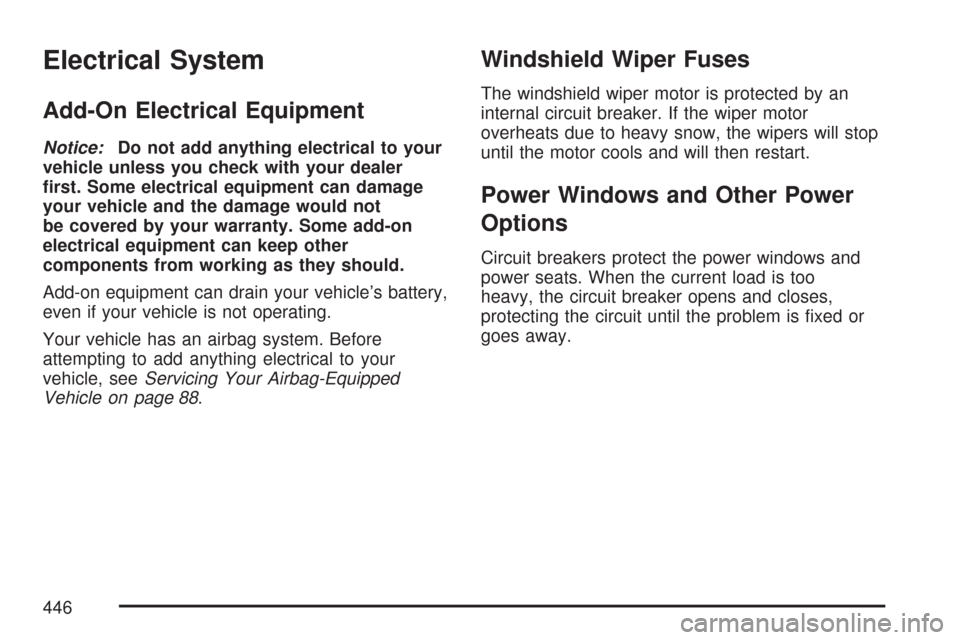Power windows CADILLAC CTS V 2007 1.G User Guide
[x] Cancel search | Manufacturer: CADILLAC, Model Year: 2007, Model line: CTS V, Model: CADILLAC CTS V 2007 1.GPages: 518, PDF Size: 2.77 MB
Page 362 of 518

If you get the Engine Coolant Hot - Idle Engine
warning with no sign of steam, try this for a minute
or so:
1. In heavy traffic, let the engine idle in
NEUTRAL (N) while stopped. If it is safe to do
so, pull off the road, shift to PARK (P) or
NEUTRAL (N) and let the engine idle.
2. Set the climate controls to the highest heat
setting and fan speed and open the windows,
as necessary.
If you no longer have the Engine Coolant
Hot - Idle Engine warning, you can drive. Just to
be safe, drive slower for about 10 minutes. If
the warning does not come back on, you can
drive normally.
If the warning continues and you have not
stopped, pull over, stop, and park your vehicle
right away.
If there is still no sign of steam, you can idle the
engine for three minutes while you are parked.
If you still have the warning,turn off the engine
and get everyone out of the vehicleuntil it
cools down.
You may decide not to lift the hood but to get
service help right away.Overheated Engine Protection
Operating Mode
This operating mode allows your vehicle to be
driven to a safe place in an emergency. Should an
hot engine condition exist, an overheat protection
mode which alternates �ring groups of cylinders
helps prevent engine damage. In this mode, there
is a loss in power and engine performance.
Driving extended miles (km) and/or towing a trailer
in the overheat protection mode should be
avoided.
Notice:After driving in the overheated engine
protection operating mode, to avoid engine
damage, allow the engine to cool before
attempting any repair. The engine oil will be
severely degraded. Repair the cause of coolant
loss and change the oil. SeeEngine Oil on
page 346.
362
Page 397 of 518

(B) Tire Width:The three-digit number indicates
the tire section width in millimeters from sidewall
to sidewall.
(C) Aspect Ratio:A two-digit number that
indicates the tire height-to-width measurements.
For example, if the tire size aspect ratio is 60,
as shown in item C of the illustration, it would
mean that the tire’s sidewall is 60 percent as high
as it is wide.
(D) Construction Code:A letter code is used to
indicate the type of ply construction in the tire.
The letter R means radial ply construction;
the letter D means diagonal or bias ply
construction; and the letter B means belted-bias
ply construction.
(E) Rim Diameter:Diameter of the wheel in
inches.
(F) Service Description:These characters
represent the load range and speed rating of the
tire. The load index represents the load carry
capacity a tire is certi�ed to carry. The load index
can range from 1 to 279. The speed rating is
the maximum speed a tire is certi�ed to carry a
load. Speed ratings range from A to Z.Tire Terminology and De�nitions
Air Pressure:The amount of air inside the tire
pressing outward on each square inch of the
tire. Air pressure is expressed in pounds
per square inch (psi) or kilopascal (kPa).
Accessory Weight:This means the combined
weight of optional accessories. Some examples of
optional accessories are, automatic transmission,
power steering, power brakes, power windows,
power seats, and air conditioning.
Aspect Ratio:The relationship of a tire’s height
to its width.
Belt:A rubber coated layer of cords that is
located between the plies and the tread. Cords
may be made from steel or other reinforcing
materials.
Bead:The tire bead contains steel wires wrapped
by steel cords that hold the tire onto the rim.
Bias Ply Tire:A pneumatic tire in which the plies
are laid at alternate angles less than 90 degrees
to the centerline of the tread.
397
Page 446 of 518

Electrical System
Add-On Electrical Equipment
Notice:Do not add anything electrical to your
vehicle unless you check with your dealer
�rst. Some electrical equipment can damage
your vehicle and the damage would not
be covered by your warranty. Some add-on
electrical equipment can keep other
components from working as they should.
Add-on equipment can drain your vehicle’s battery,
even if your vehicle is not operating.
Your vehicle has an airbag system. Before
attempting to add anything electrical to your
vehicle, seeServicing Your Airbag-Equipped
Vehicle on page 88.
Windshield Wiper Fuses
The windshield wiper motor is protected by an
internal circuit breaker. If the wiper motor
overheats due to heavy snow, the wipers will stop
until the motor cools and will then restart.
Power Windows and Other Power
Options
Circuit breakers protect the power windows and
power seats. When the current load is too
heavy, the circuit breaker opens and closes,
protecting the circuit until the problem is �xed or
goes away.
446
Page 507 of 518

Driver Information Center (DIC) (cont.)
DIC Warnings and Messages................... 232
Status of Vehicle Systems........................ 223
System Controls....................................... 223
Driving
At Night................................................... 305
City.......................................................... 310
Defensive................................................. 286
Drunken................................................... 287
Freeway................................................... 311
Hill and Mountain Roads.......................... 314
In Rain and on Wet Roads...................... 306
Rocking Your Vehicle to Get it Out.......... 321
Winter...................................................... 316
Dual Climate Control System....................... 189
E
Electrical System
Add-On Equipment................................... 446
Fuses and Circuit Breakers...................... 447
Power Windows and Other
Power Options...................................... 446
Rear Underseat Fuse Block..................... 451Electrical System (cont.)
Underhood Fuse Block............................. 447
Windshield Wiper Fuses........................... 446
Engine
Air Cleaner/Filter...................................... 351
Check and Service Engine Soon Light..... 209
Check Oil Pressure Message................... 220
Coolant.................................................... 356
Coolant Heater......................................... 120
Coolant Temperature Gage...................... 208
Coolant Temperature Warning Light.......... 207
Drive Belt Routing.................................... 476
Engine Compartment Overview................ 342
Exhaust................................................... 134
Oil ........................................................... 346
Oil Life System........................................ 349
Oil Temperature Warning Message ........... 220
Overheated Protection
Operating Mode.................................... 362
Overheating............................................. 360
Speed Limiter.......................................... 201
Starting.................................................... 119
Entry Lighting.............................................. 184
Event Data Recorders (EDR)...................... 494
Extender, Safety Belt..................................... 41
Exterior Lighting Battery Saver.................... 183
507
Page 513 of 518

Passenger Compartment Air Filter............... 195
Passenger Sensing System........................... 82
Passing....................................................... 301
Power
Door Locks.............................................. 101
Electrical System..................................... 446
Lumbar Controls........................................ 10
Retained Accessory (RAP)....................... 119
Seat............................................................ 9
Steering Fluid.......................................... 368
Windows.................................................. 108
Pretensioners, Safety Belt............................. 41
Programmable Automatic Door Locks.......... 102
Q
Questions and Answers About
Safety Belts............................................... 24
R
Radios........................................................ 258
Care of Your CD Player........................... 283
Care of Your CDs.................................... 283
Navigation/Radio System, see
Navigation Manual................................ 279
Radio with CD......................................... 260Radios (cont.)
Setting the Time...................................... 259
Theft-Deterrent......................................... 279
Understanding Reception......................... 282
Reading Lamps........................................... 185
Rear Axle.................................................... 382
Limited-Slip.............................................. 297
Rear Door Security Locks........................... 103
Rear Safety Belt Comfort Guides.................. 38
Rear Seat Passengers, Safety Belts.............. 34
Rearview Mirror, Automatic Dimming
with OnStar
®............................................ 136
Rearview Mirror, Automatic Dimming
with OnStar
®and Compass..................... 137
Reclining Seatbacks...................................... 14
Recommended Fluids and Lubricants.......... 473
Recon�gurable Steering Wheel Controls...... 169
Recreational Vehicle Towing........................ 326
Remote Keyless Entry (RKE) System............ 96
Remote Keyless Entry (RKE) System,
Operation................................................... 97
Removing the Flat Tire and Installing
the Spare Tire.......................................... 426
Removing the Spare Tire and Tools............ 425
Replacement Bulbs..................................... 389
Reporting Safety Defects
Canadian Government............................. 500
513
Page 518 of 518

Where to Put the Restraint............................ 54
Windows..................................................... 107
Power...................................................... 108
Windshield
Washer.................................................... 174
Washer Fluid........................................... 369
Wiper Blade Replacement........................ 390
Wiper Blades, Cleaning............................ 441
Wiper Fuses............................................ 446
Wipers..................................................... 173
Winter Driving............................................. 316
Winter Tires................................................. 393
Wiper Activated Headlamps......................... 180X
XM Radio Messages................................... 277
XM™ Satellite Radio Antenna System......... 284
Y
Your Vehicle and the Environment............... 460
518